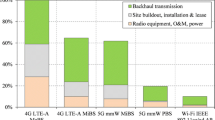Abstract
5G wireless telecommunications require rapid data traffic and high network speed. Thus, it is important to focus on technologies that are capable of meeting these high demands. On the other hand, the cost calculation of installing, maintaining and operating a network deployment, plays an important role for its adoption by an enterprise or a network provider. In this paper, there is a presentation of cost models for distributed antenna systems and small cells, because these two technologies offer significant benefits and meet the needs of the next generation of mobile networking. A sensitivity analysis of several network components, such as the allocated bandwidth, the running costs, the periodical interest rate, the base station, the equipment, the power consumption, the backhauling, the implementation costs and throughput density is analyzed. Throughput density and several important information are listed and calculated, according to public data. All these components are tested, using parameters and variables to represent them in mathematical equations model resulting in a cost provision for the next 5 years. Then, the overall and the individual costs are computed, namely the total cost of ownership, the Capital (CAPEX) and the Operational (OPEX) expenditures for several throughput density prices according to the suggested pricing models. The paper concludes by drawing fundamental conclusions for the expenses and as a result, for the viability of each technological suggestion and it ends up offering ideas for future research activity in the field.
















Similar content being viewed by others
References
Expert Working Group. (2014) What is 5G (really) about? Technical report, NetWorld 2020 ETP, 2014.
Greek national plan of broadband access of the new generation 2014–2020. Technical report, Ministry of Infrastractures, Transportations and Networks, October 2014.
Arif, M., Yameen, I. M., & Matin, M. A. (2013). Femtocell suburban deployment in LTE networks. International Journal of Information and Electronics Engineering, 3(2), 208.
Bouras, C., Kokkinos, V., Kollia, A. Papazois, & A. (2015). Techno-economic analysis of ultra-dense and DAS deployments in mobile 5G. In IEEE International Symposium on Wireless Communications Systems, 2015 (ISWCS 2015), August 2015.
Bouras, C., Kokkinos, V., & Papazois, A. (2014). Financing and pricing small cells in next-generation mobile networks. In Wired/Wireless Internet Communications, Lecture Notes in Computer Science. Springer: Berlin Heidelberg, 2014.
Chandrasekhar, V., Andrews, J., & Gatherer, A. (2008). Femtocell networks: A survey. IEEE Communications Magazine, 46(9), 59–67.
Correia, L., Zeller, D., Blume, O., Ferling, D., Jading, Y., Gdor, I., et al. (2010). Challenges andenabling technologies for energy aware mobile radio networks. IEEE Communications Magazine, 48(11), 66–72.
Duan, L., Huang, J., & Shou, B. (2013). Economics of femtocell service provision. IEEE Transactions on, Mobile Computing, 12(11), 2261–2273.
Expert Working Group. (2014). 5G: Challenges, research priorities, and recommendations. Technical report, Net- World 2020 ETP, September 2014.
Expert Working Group. (2014). Next generation of wireless networks. Technical report, NetWorld 2020 ETP, 2014.
Cardoso, J. B., & Arora, J. S. (1988). Variational method for design sensitivity analysis in nonlinear structural mechanics. AIAA Journal, 26(5), 595–603.
Expert Working Group. (2015). 5G whitepaper. Technical report, NGMN Alliance, February 2015.
Guvenc, I., Quek, T., Kountouris, M., & Lopez-Perez, D. (2013). Heterogeneous and small cell networks: part 1 [guest editorial]. IEEE Communications Magazine, 51(5), 34–35.
Johansson, K., Furuskar, A., Karlsson, P., & Zander, J. (2004). Relation between base station characteristics and cost structure in cellular systems. In 15th IEEE International Symposium on, Personal, Indoor and Mobile Radio Communications, 2004. PIMRC 2004. 4 2627–2631.
Kim, R., Kwak, J. S., & Etemad, K. (2009). Wimax femtocell: requirements, challenges, and solutions. IEEE Communications Magazine, 47(9), 84–91.
Liu, Z. (2013). Techno-economic Analysis of Indoor Enterprise Solutions. PhD thesis, Aalborg University, December 2013.
Liu, Z., Kolding, T., Mogensen, P., Vejgaard, B., & Sorensen, T. (2012) Economical comparison of enterprise in-building wireless solutions using das and femto. In Vehicular Technology Conference (VTC Fall), 2012 IEEE, pp. 1–5, Sept 2012.
Markendahl, J., & Mkitalo, O. (2010) A comparative study of deployment options, capacity and cost structure for macrocellular and femtocell networks. In Personal, Indoor and Mobile Radio Communications Workshops (PIMRC Workshops), 2010 IEEE 21st International Symposium on, pp. 145–150, 2010.
Xiao, M., Shro, N., & Chong, E. (2001). Utility-based power control in cellular wireless systems. In Proceedings. IEEE, INFOCOM2001. Twentieth Annual Joint Conference of the IEEE Computer and Communications Societies. vol 1, pp. 412–421.
Zhu, L., Aurum, A., Gorton, I., & Jeery, R. (2005). Trade of and sensitivity analysis in software architectureevaluation using analytic hierarchy process. Software Quality Journal, 13(4), 357–375.
Author information
Authors and Affiliations
Corresponding author
Rights and permissions
About this article
Cite this article
Bouras, C., Kollia, A. & Papazois, A. Dense Deployments and DAS in 5G: A Techno-Economic Comparison. Wireless Pers Commun 94, 1777–1797 (2017). https://doi.org/10.1007/s11277-016-3711-0
Published:
Issue Date:
DOI: https://doi.org/10.1007/s11277-016-3711-0




